The Best Quick Workouts To Keep On Top Of Your Fitness Goals on Holiday
August 07 2023 6 min read
We all know that holidays are made for relaxation, but no one wants to fall out of routine and lose the hard-earned progress they’ve been making.
Staying active when you travel can help keep your energy levels up, stress down and muscle tension in check. But what are some of the best quick workouts you can incorporate into your holiday?
At Fitness First, our experts have pulled together some of their favourite exercises that help keep them on track even when they’re soaking up the sun!
Should you exercise whilst on holiday?
When your workout roadmap is clearly laid out, and you’ve got the right plan in place, getting or staying in shape isn’t as hard as you may think. And, whether you plan to exercise on holiday or not is all down to personal preference.
Tim Andrews, Head of Fitness Product, at Fitness First, explains, “For some, the routine of working out is something that they want to incorporate into their holiday. Staying active on holiday allows you to explore new opportunities and really make the most of your destination — whether it’s going for a jog along the beach, trying out water sports or taking a hike to enjoy the scenic views. In fact, exercise can even help alleviate some travel-related stress or jet lag, leaving you feeling rejuvenated and ready to enjoy your holiday to the fullest.
But remember, taking a break from your daily routine doesn’t mean neglecting your mental well-being! Of course, it's important to strike a balance between staying active and allowing yourself time to relax and recharge. Don't feel pressured to maintain the same intensity or duration of workouts as you would at home.”
What are the benefits of working out whilst on holiday?
Working out whilst you’re catching some summer rays can have a wide range of benefits, whether you’re opting for water aerobics or a run on the beach:
1. Maintain fitness levels
Regular exercise can help maintain your fitness levels, ensuring you don’t experience a significant decline in your strength, endurance or cardiovascular health during your time away. This is especially important if you have been working hard to achieve specific fitness goals or if you're preparing for an upcoming event or competition.
2. Boost energy
Exercise has an incredible way of energising us. When you engage in physical activity, your body releases dopamine and endorphins, the mood-boosting chemicals that leave you feeling revitalised and ready to take on the world. So, by working out on your holiday, you'll have more energy to explore and have fun.
3. Manage stress
Holidays are meant to be a time to relax, but sometimes travel-related stress can creep in. Since exercise is a natural stress reliever, it can help to reduce anxiety and promote a sense of calmness. So, whether it’s a gentle jog or a swim in the pool, working out can help you destress from the day.
4. Stay on track
We all know that holidays involve trying new cuisine and indulging in everything from midday snacks to delicious desserts. While treating yourself is a part of the experience, incorporating exercise can help you manage your weight and goals while away. By balancing enjoying tasty treats and staying active, you can savour all the flavours guilt-free.
5. Embark on adventures
If you’re the adventurous type, working out during your holidays can open up a wide world of exploration. Depending on the type of holiday you’re on, you can go for a scenic run along the beach, hike breathtaking trails, or try out exciting activities like kayaking or paddleboarding. It's a chance to immerse yourself in the local environment and experience new thrills!
Remember, the key is finding a balance that works for you. You don't have to follow a strict exercise regimen—just enjoy moving your body and finding joy in staying active. So, whether it's a leisurely stroll, a friendly game of beach volleyball, or an adventurous hike, working out on holiday will leave you feeling energised and help you make the most of your well-deserved break.
Quick workouts to do while on holiday
Here are some quick exercises that you can easily incorporate into your holiday routine in between sunbathing and jumping in the pool to cool off:
Circuit 1:
Glute Kickbacks
The glute kickback is an isolation exercise which works all three of the gluteal muscles — gluteus maximus, gluteus medius and gluteus minimus.
To perform the exercise:
- Start on all fours with your hands directly under your shoulders and your knees under your hips.
- Engage your core and lift one leg straight back, keeping it in line with your body.
- Squeeze your glutes at the top and slowly lower your leg back to the starting position.
- Alternate legs for the recommended number of reps below.
- Beginner — Perform 2 sets of 10-12 reps per leg, resting for 30 seconds between sets. You can perform this exercise without any resistance bands or weights.
- Intermediate — Perform 3 sets of 12-15 reps (each leg), resting for 20 seconds between sets. You can use ankle weights or resistance bands for added intensity.
- Advanced — Perform 4 sets of 15-20 reps (each leg), resting for 15 seconds between sets. Increase the resistance by using heavier ankle weights or resistance bands.
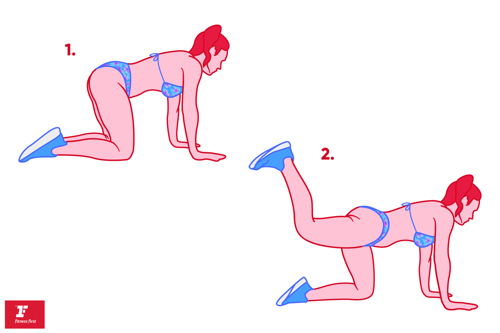
Planks
The plank exercise works your entire core, especially the rectus abdominis. It involves maintaining a position similar to a push-up for as long as you can.
To perform this exercise:
- Start in a high plank position with your hands directly under your shoulders and your body in a straight line from head to heels.
- Engage your core, squeeze your glutes and hold the position for the recommended time below based on your fitness level.
- Beginner — Hold the plank for 20-30 seconds, rest for 30 seconds, and repeat for 2 sets. You can modify it by performing the plank on your forearms and making it easier.
- Intermediate — Hold the plank for 30-45 seconds, rest for 20 seconds, and repeat for 3 sets.
- Advanced — Hold the plank for 45-60 seconds, rest for 15 seconds, and repeat for 4 sets. Try performing the plank with leg lifts or arm reaches to increase difficulty.
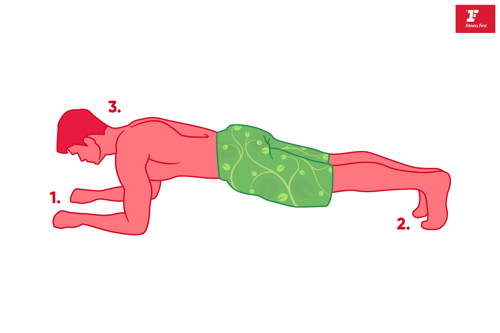
Jump Squats
Jump squats are a bodyweight exercise characterised by leaping upward at the top of the movement.
To perform this exercise:
- Start with your feet shoulder-width apart.
- Lower your body into a squat position, keeping your weight on your heels and your chest lifted.
- Quickly jump up, extending your hips and knees fully.
- Land softly, immediately lowering back into the squat position to repeat.
- Beginner — Perform two sets of 8-10 reps, resting for 30 seconds between sets. Modify by reducing the depth of the squat and performing smaller jumps if this feels better for you.
- Intermediate — Perform 3 sets of 10-12 reps, resting for 20 seconds between sets.
- Advanced — Perform 4 sets of 12-15 reps, resting for 15 seconds between sets. Increase intensity by jumping higher or adding a tuck jump at the peak of the movement.
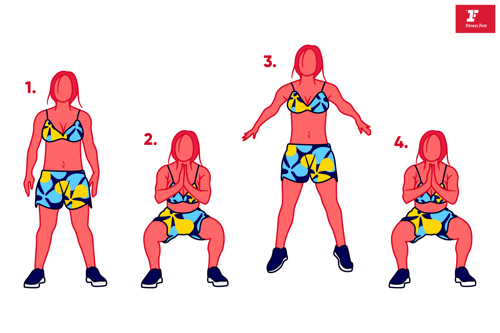
Push-ups
When performed properly, the push-up is a compound exercise that uses the muscles in your chest, shoulders, back, abs, triceps and legs.
To perform this exercise:
- Start in a high plank position with your hands slightly wider than shoulder-width apart.
- Lower your body by bending your elbows, keeping your core engaged and your back flat.
- Go down until your chest nearly touches the ground, then push through your palms to return to the starting position.
- Beginner — Perform 2 sets of 6-8 reps, resting for 30 seconds between sets. You can modify it by doing push-ups on your knees or against a wall.
- Intermediate — Perform 3 sets of 8-12 reps, resting for 20 seconds between sets.
- Advanced — Perform 4 sets of 12-15 reps, resting for 15 seconds between sets. To increase difficulty, try diamond push-ups or decline push-ups. A diamond push-up is a more advanced version of the classic push-up, instead bringing your hands close together to form a diamond or triangle shape below the chest. A decline push-up is performed with your feet on an elevated surface, putting your body on a downward angle.
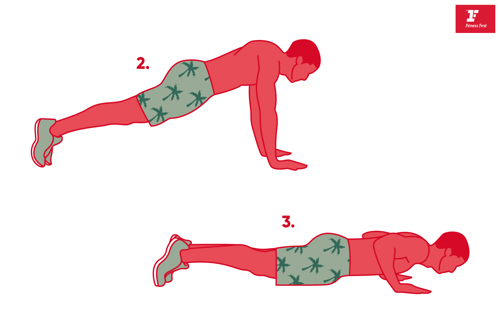
Circuit 2:
Jump Lunges
This lower-body exercise involves the use of the quads, glutes, hamstrings and calves. It aims to help you gain muscle mass, mainly in your glutes.
To perform this exercise:
- Start in a lunge position with your right leg forward and your left leg extended behind you.
- Lower your body into a lunge, keeping your front knee aligned with your ankle.
- Explosively jump up, switching your leg positions in mid-air.
- Land softly with your left leg forward and your right leg extended behind you.
- Repeat the movement for the recommended number of reps below.
- Beginner — Perform 2 sets of 8-10 reps (each leg), resting for 30 seconds between sets. You can perform stationary lunges instead of the jumping variation.
- Intermediate — Perform 3 sets of 10-12 reps (each leg), resting for 20 seconds between sets.
- Advanced — Perform 4 sets of 12-15 reps (each leg), resting for 15 seconds between sets. Increase intensity by jumping higher or adding a tuck jump when switching legs.
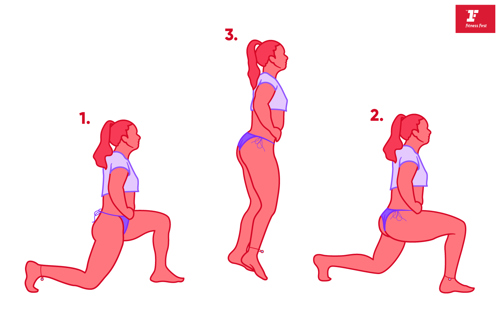
Bird Dogs
This bodyweight exercise targets your back and core muscles.
To perform this exercise:
- Start on all fours with your hands directly under your shoulders and your knees under your hips.
- Extend your right arm forward while simultaneously extending your left leg backwards.
- Keep your core engaged and your hips stable.
- Hold the position momentarily, then return to the starting position.
- Repeat with the opposite arm and leg.
- Beginner — Perform 2 sets of 8-10 reps (each side), resting for 30 seconds between sets.
- Intermediate — Perform 3 sets of 10-12 reps (each side), resting for 20 seconds between sets.
- Advanced — Perform 4 sets of 12-15 reps (each side), resting for 15 seconds between sets. Increase difficulty by holding the extended position for longer or using ankle weights.
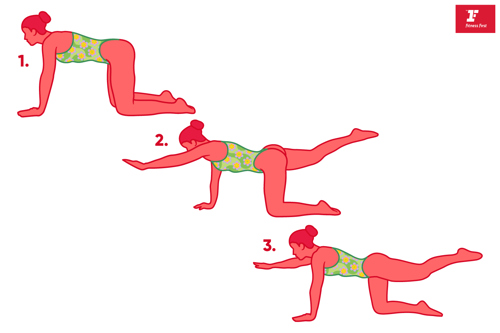
Flutter Kicks
Flutter kicks work the core muscles, specifically the lower rectus abdominal muscles and the hip flexors.
To perform this exercise:
- Lie flat on your back with your legs extended and your arms by your sides.
- Lift your legs a few inches off the ground.
- Keep your core engaged and alternate kicking your legs up and down in a controlled motion.
- Beginners — Perform 2 sets of 15-20 reps (each leg), resting for 30 seconds between sets. You can place your hands under your glutes for added support.
- Intermediate — Perform 3 sets of 20-25 reps (each leg), resting for 20 seconds between sets.
- Advanced — Perform 4 sets of 25-30 reps (each leg), resting for 15 seconds between sets. Increase difficulty by slowing down the movement or performing scissor kicks.
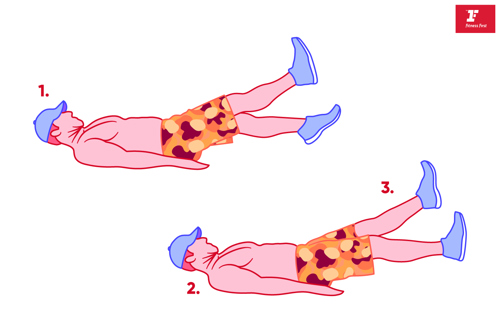
Burpees
A burpee is essentially a two-part exercise consisting of a push-up followed by a leap in the air.
To perform this exercise:
- Start in a standing position with your feet shoulder-width apart.
- Lower your body into a squat position and place your hands on the ground in front of you.
- Jump your feet back, landing in a high plank position.
- Perform a push-up, then jump your feet forward back into the squat position.
- Explosively jump up, reaching your hands overhead.
- Beginner — Perform 2 sets of 6-8 reps, resting for 30 seconds between sets. If unable to do burpees, substitute with jumping jacks.
- Intermediate — Perform 3 sets of 8-12 reps, resting for 20 seconds between sets.
- Advanced — Perform 4 sets of 12-15 reps, resting for 15 seconds between sets. Add a tuck jump at the end of each rep to increase the intensity.
If you can’t perform a burpee, then feel free to swap this out with jumping jacks instead.
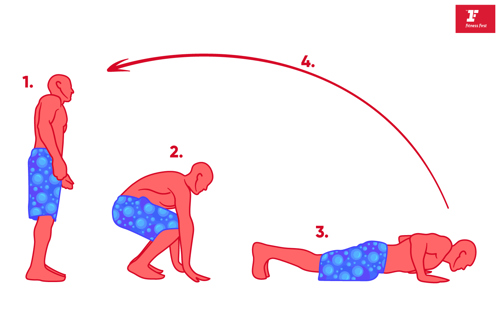
Circuit 3:
Crab Walks
The crab walk is an intense upper body and core workout that uses your own body weight for resistance.
To perform this exercise:
- Start by sitting on the ground with your feet hip-width apart and your hands resting behind you, fingers pointing toward your feet.
- Lift your hips off the ground, creating a tabletop position.
- Begin walking sideways, moving one hand and the opposite foot at the same time.
- Continue walking for the recommended distance or time.
- Beginners — Perform 2 sets of 10-12 steps in each direction, resting for 30 seconds between sets. Take smaller steps and focus on stability.
- Intermediate — Perform 3 sets of 12-15 steps in each direction, resting for 20 seconds between sets. Take larger steps and increase the speed of movement.
- Advanced — Perform 4 sets of 15-20 steps in each direction, resting for 15 seconds between sets. Increase the speed and challenge by adding resistance bands or weights.
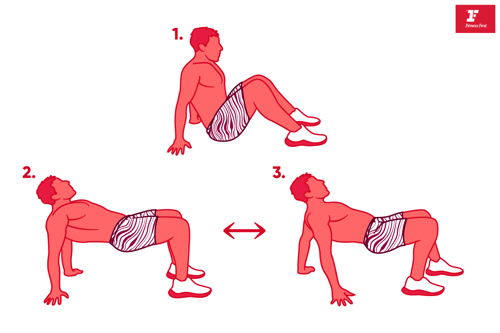
Sit-ups
Sit-ups are a classic abdominal exercise performed by lying on your back and lifting your torso.
To perform this exercise:
- Lie on your back with your knees bent and your feet flat on the ground.
- Place your hands behind your head or crossed on your chest.
- Engage your core and lift your upper body off the ground, curling toward your knees.
- Slowly lower yourself back down to the starting position.
- Beginner — Perform 2 sets of 8-10 reps, resting for 30 seconds between sets. You can anchor your feet under something sturdy or use a stability ball for assistance.
- Intermediate — Perform 3 sets of 10-12 reps, resting for 20 seconds between sets.
- Advanced — Perform 4 sets of 12-15 reps, resting for 15 seconds between sets. Increase the difficulty by adding a twist at the top or holding a weight plate.
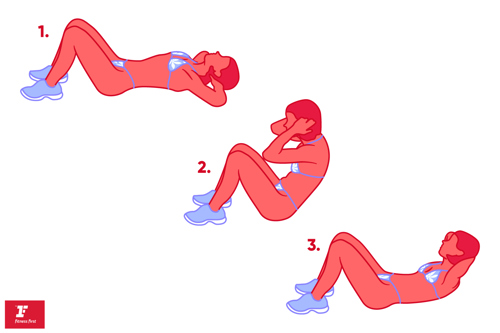
Skaters
Skaters are a cardiovascular exercise where you perform a lateral jump. It helps strengthen your legs, improve stability and balance and increase your heart rate.
To perform this exercise:
- Start by standing with your feet hip-width apart and your knees slightly bent.
- Take a lateral leap to the right, landing on your right foot while swinging your left leg behind you.
- Quickly push off with your right foot and leap to the left, landing on your left foot and swinging your right leg behind you.
- Repeat the side-to-side motion for the recommended number of reps.
- Beginners — Perform 2 sets of 8-10 reps on each side, resting for 30 seconds between sets. Take smaller jumps and focus on balance.
- Intermediate — Perform 3 sets of 10-12 reps on each side, resting for 20 seconds between sets. Increase the speed and distance of the jumps.
- Advanced — Perform 4 sets of 12-15 reps on each side, resting for 15 seconds between sets. Add a hop or a squat at the end of each jump for an extra challenge.
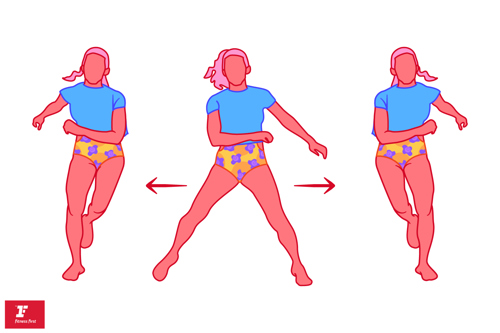
Glute Bridges
This simple exercise activates your glutes and increases your core stability.
To perform this exercise:
- Lie on your back with your knees bent and your feet flat on the ground, hip-width apart.
- Place your arms by your sides, palms facing down.
- Press through your heels, engage your glutes, and lift your hips off the ground until your body forms a straight line from shoulders to knees.
- Hold the position for a moment, then slowly lower your hips back down.
- Beginners — Perform 2 sets of 10-12 reps, resting for 30 seconds between sets. Focus on proper form and activation of the glutes.
- Intermediate — Perform 3 sets of 12-15 reps, resting for 20 seconds between sets. Increase the range of motion by lifting your hips higher.
- Advanced — Perform 4 sets of 15-20 reps, resting for 15 seconds between sets. Add an extra challenge by placing a resistance band above your knees or by performing single-leg glute bridges, lifting one foot off the ground while keeping the hips level.
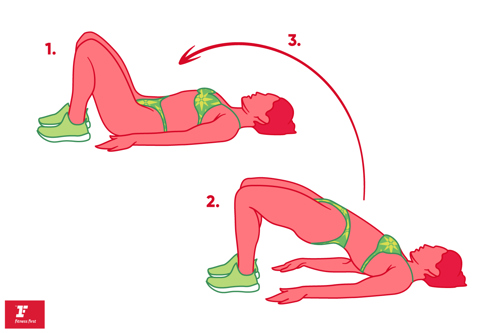
Get holiday ready with Fitness First Classes
Now you know how to train whilst on holiday, it’s time to put your newfound knowledge to the test. And, once you’re back from your break, we have a wide range of fitness classes, personal training sessions and more for you to take on.
Book a club visit to come and experience our facilities for free. Or, for more helpful tips and advice on fitness and nutrition, check out our blog.